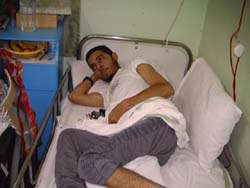01 September 2010
A bullet in the leg for 3 shekels?
Voices From The OccupationHasan W. Age 17 (a child by UN definition)Date of Incident: 22 May 2010
Location: The Gaza Strip, Occupied Palestinian Territory
.
Seventeen year old Hasan lives with his parents and seven brothers and sisters in Jabalia, a town in the north of the Gaza Strip, close to the Erez Checkpoint with 'Israel'.
Hasan dropped out of school in the seventh grade ‘because I wasn’t good
enough and couldn’t pass my classes’ and struggles to find work in Gaza where
a severe physical and economic blockade has been imposed by Israel since at
least June 2007.
The family’s economic situation is bleak. ‘My father sells gas containers,’ says
17-year-old Hasan, ‘but he has little work because of the gas shortage caused by
the blockade. He only works a few days a month, and the money he makes barely
meets the needs of our ten-member family.’ In February, Hasan heard about a
job opportunity from his cousin, where he could earn between 30 and 50 NIS per
day (US $8 to 13) collecting gravel near the border with Israel and used for
building material. Although modest, this income was desperately needed by the
family. ‘We don’t have much gravel in Gaza because Israel doesn’t allow the entry of construction materials, so I decided to go there. I would wake up everyday at dawn, prepare the donkey cart, and later sell the gravel for 3 NIS
(US $0.80) a bucket to the people trading in construction materials,’ recalls Hasan.
On Saturday, 22 May 2010, Hasan went as usual to the industrial zone to collect gravel with his cousin. ‘Many other youngsters and children were working in the same area with us,’ remembers Hasan. ‘There were around 100 workers or even more. Israeli soldiers were observing us from the watch tower on the border, and would sometimes fire bullets in the air or at us, or at the donkeys. Sometimes they actually shot the donkeys.’
At around 6:30am, Hasan heard a gun shot. ‘I was collecting gravel with the other workers about 300 metres from the border fence, when one of the Israeli
soldiers in the watch tower fired a shot which hit me in the right leg. I immediately fell to the ground in great pain. Everyone started running away, except for one youngster who I didn’t know, who came and tried to help me, but he couldn’t lift me.’ In the meantime, the soldiers kept firing and the boy who came to help Hasan also had to run away.
‘I stayed on the ground for about 15 minutes whilst my leg was bleeding,’ recalls Hasan, ‘then my cousin arrived and took me to the main street in his donkey cart.’ Soon afterwards an ambulance arrived and rushed Hasan to Kamal
Odwan Hospital, where his wound was treated and his shattered leg was placed in plaster.
'My leg was in plaster for two months,’ says Hasan, ‘and now I still can’t walk properly and feel pain whenever I move it. I don’t know when I will be able to walk again, and I know I won’t be able to go back to collecting gravel, even though my family needs the money, and there are no other alternatives.’
According to the UNDP and the Palestinian Central Bureau of Statistics, during the first half of 2009, the youth unemployment rate in Gaza for 15 to 19 year-olds reached 57.5 percent.
(From DCI with thanks)
NB Image is of Jawwal employee rendered paraplegic by 'Israeli' bullet at Khan Younis checkpoint ?2003. Picture taken in El Wafa hospital.

